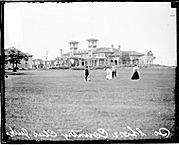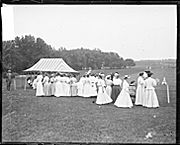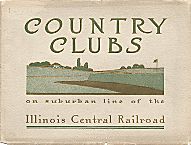| Entries |
| G |
|
Golf
|
Upper-class Easterners and Midwesterners founded the first permanent golf courses and country clubs in the late 1880s. Metropolitan Chicago was ideally suited for golf. Its booming economy provided an economic and social elite with the leisure time and wealth to pursue the game, and its network of commuter railroads provided easy access to the proliferating number of suburban country clubs.

|
Macdonald joined members of four equally exclusive eastern clubs in December 1894 to form the United States Golf Association (USGA). He won the association's first U.S. Amateur in 1895 and, as an officer, was instrumental in making the USGA the acknowledged national governing body of golf.

|
Following the nationwide golf boom of the 1920s, golf in Chicago, as elsewhere, suffered from the Great Depression and World War II. Many private courses folded and war rationing brought equipment shortages, “fairway gardens,” and transportation problems. Chicago, however, stood at the forefront of a new boom that began in the 1950s. George S. May's World Championship at Tam O'Shanter became the PGA tour's richest event and in 1953 the first golf tournament to be televised nationally.

|
What Macdonald had done for the world of private golf, Chicago pro Joe Jemsek did for twentieth-century public golf. The son of Russian immigrants, Jemsek purchased St. Andrews Country Club in 1939, determined to provide private course conditions for public course players. He continued to buy, sell, and build high-quality public courses, capped by the opening in 1967 of Dubsdread, his fourth course at suburban Cog Hill in Lemont. By the mid-1990s he owned seven courses, and similar “upscale” public courses were spreading throughout the country. Chicago courses of this type and those elsewhere benefited from a nationwide controversy over the restrictive membership policies of many private clubs, which, for example, cost Chicago Golf Club the 1993 Walker Cup. In 1991, Dubsdread became the permanent home of the Western Open, after it was moved from the all-male Butler National; earlier, local insurance executive James Kemper had secured the 1989 PGA Championship for his public Kemper Lakes in Long Grove, one of several area courses operated by Kemper Sports Management.
Despite the profusion of courses, however, metropolitan Chicago, with more than 850,000 golfers, was still well below the national average for courses per golfer.
The Encyclopedia of Chicago © 2004 The Newberry Library. All Rights Reserved. Portions are copyrighted by other institutions and individuals. Additional information on copyright and permissions.